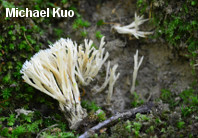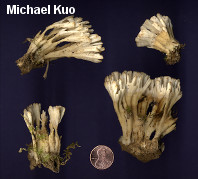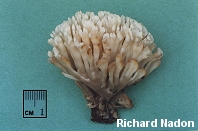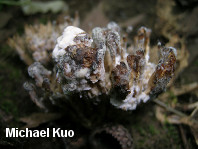| Major Groups > Clubs & Corals / Jelly Fungi > Tremellodendron pallidum |

|
Tremellodendron schweinitzii [ Basidiomycota > Sebacinales > Sebacinaceae > Tremellodendron ... ] by Michael Kuo In my area, Tremellodendron schweinitzii (also known as Tremellodendron pallidum) is by far the most common of the coral mushrooms--except that it's not, strictly speaking, a "coral mushroom." Believe it or not, mycologists place it with the jelly fungi, on the basis of the microscopic structure of its spore-producing basidia. Thus, some authors give Tremellodendron schweinitzii the common name "false coral." Tremellodendron schweinitzii takes forever and a day to develop, and is often seen in its primordial stage just after morel season, in spring. At this point it looks more or less like (sorry) bird droppings on the forest floor. Within a few weeks, however, it has begun to develop an approximation of the fruiting body to come. Weeks later, it is tough and sturdy--and still growing. Some specimens continue growing well into late summer or fall, losing their pristine whiteness and beginning to demonstrate the colors of whatever substrate they are growing in. Tremellodendron pallidum is a synonym, representing a taxonomic error on the part of Burt (1915), and the taxonomically invalid name pallidum has persisted for 100 years in many sources (including field guides I have authored). However, Tremellodendron schweinitzii is the correct name--although a study by Walker and Parrent (2004) discovered that several collections labeled "Tremellodendron pallidum" and "Tremellodendron schweinitzii" were phylogenetically distinct, raising the possibility that what mycologists call "cryptic species" may exist within our current concept of Tremellodendron schweinitzii. The 2004 study also bolstered the idea that species of Tremellodendron are mycorrhizal rather than saprobic, as had traditionally been assumed. Description: Ecology: Mycorrhizal with oaks and possibly with other hardwoods; growing alone or gregariously on the ground, in soil or in moss; spring through late fall; widely distributed east of the Great Plains (also reported from New Mexico and Texas). The illustrated and described collections are from Illinois and Québec. Fruiting Body: At first a whitish patch of fuzz, developing over a few weeks into a coral-like structure up to 10 cm high and 6 cm wide, with flattened branches arising from fused bases. Branches: Flattened; bald; dry; whitish to buff when fresh and young, becoming yellowish with age and often developing green shades (from algae) when very old; tips flattened, colored like the branches, becoming somewhat ragged with age. Flesh: Stringy and very tough; whitish. Odor and Taste: Odor not distinctive; taste slightly bitter. Chemical Reactions: Iron salts negative on branches. Spore Print: White. Microscopic Features: Spores 7-12 x 4-6 µ; allantoid; hyaline in KOH; smooth. Basidia longitudinally cruciate-septate; ovoid to pyriform; to REFERENCES: (Peck, 1878) Atkinson, 1902. (Bodman, 1942; Martin, 1952; Lowy, 1971; Smith, Smith & Weber, 1981; Phillips, 1991/2005; Lincoff, 1992; Metzler & Metzler, 1992; Barron, 1999; Roody, 2003; Walker & Parrent, 2004; McNeil, 2006; Miller & Miller, 2006; Kuo & Methven, 2008; Kuo & Methven, 2014.) Herb. Kuo 06010401, 07020706, 06211401. This site contains no information about the edibility or toxicity of mushrooms. |
© MushroomExpert.Com |
|
Cite this page as: Kuo, M. (2014, November). Tremellodendron schweinitzii . Retrieved from the MushroomExpert.Com Web site: http://www.mushroomexpert.com/tremellodendron_ schweinitzii.html |



